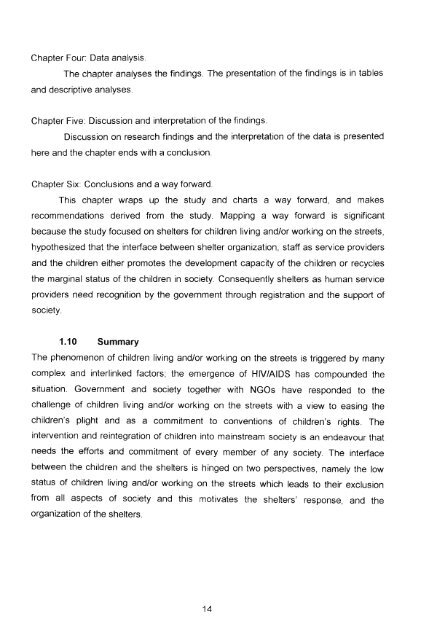A Study of Shelters for Street Children from an Organizational ...
A Study of Shelters for Street Children from an Organizational ...
A Study of Shelters for Street Children from an Organizational ...
Create successful ePaper yourself
Turn your PDF publications into a flip-book with our unique Google optimized e-Paper software.
Chapter Four: Data <strong>an</strong>alysis.<br />
The chapter <strong>an</strong>alyses the findings. The presentation <strong>of</strong> the findings is in tables<br />
<strong>an</strong>d descriptive <strong>an</strong>alyses.<br />
Chapter Five: Discussion <strong>an</strong>d interpretation <strong>of</strong> the findings.<br />
Discussion on research findings <strong>an</strong>d the interpretation <strong>of</strong> the data is presented<br />
here <strong>an</strong>d the chapter ends with a conclusion.<br />
Chapter Six: Conclusions <strong>an</strong>d a way <strong>for</strong>ward.<br />
This chapter wraps up the study <strong>an</strong>d charts a way <strong>for</strong>ward, <strong>an</strong>d makes<br />
recommendations derived <strong>from</strong> the study. Mapping a way <strong>for</strong>ward is signific<strong>an</strong>t<br />
because the study focused on shelters <strong>for</strong> children living <strong>an</strong>d/or working on the streets,<br />
hypothesized that the interface between shelter org<strong>an</strong>ization, staff as service providers<br />
<strong>an</strong>d the children either promotes the development capacity <strong>of</strong> the children or recycles<br />
the marginal status <strong>of</strong> the children in society. Consequently shelters as hum<strong>an</strong> service<br />
providers need recognition by the government through registration <strong>an</strong>d the support <strong>of</strong><br />
society.<br />
1.10 Summary<br />
The phenomenon <strong>of</strong> children living <strong>an</strong>d/or working on the streets is triggered by m<strong>an</strong>y<br />
complex <strong>an</strong>d interlinked factors; the emergence <strong>of</strong> HIV/AIDS has compounded the<br />
situation. Government <strong>an</strong>d society together with NGOs have responded to the<br />
challenge <strong>of</strong> children living <strong>an</strong>d/or working on the streets with a view to easing the<br />
children's plight <strong>an</strong>d as a commitment to conventions <strong>of</strong> children's rights. The<br />
intervention <strong>an</strong>d reintegration <strong>of</strong> children into mainstream society is <strong>an</strong> endeavour that<br />
needs the ef<strong>for</strong>ts <strong>an</strong>d commitment <strong>of</strong> every member <strong>of</strong> <strong>an</strong>y society. The interface<br />
between the children <strong>an</strong>d the shelters is hinged on two perspectives, namely the low<br />
status <strong>of</strong> children living <strong>an</strong>d/or working on the streets which leads to their exclusion<br />
<strong>from</strong> all aspects <strong>of</strong> society <strong>an</strong>d this motivates the shelters' response, <strong>an</strong>d the<br />
org<strong>an</strong>ization <strong>of</strong> the shelters.<br />
14

















